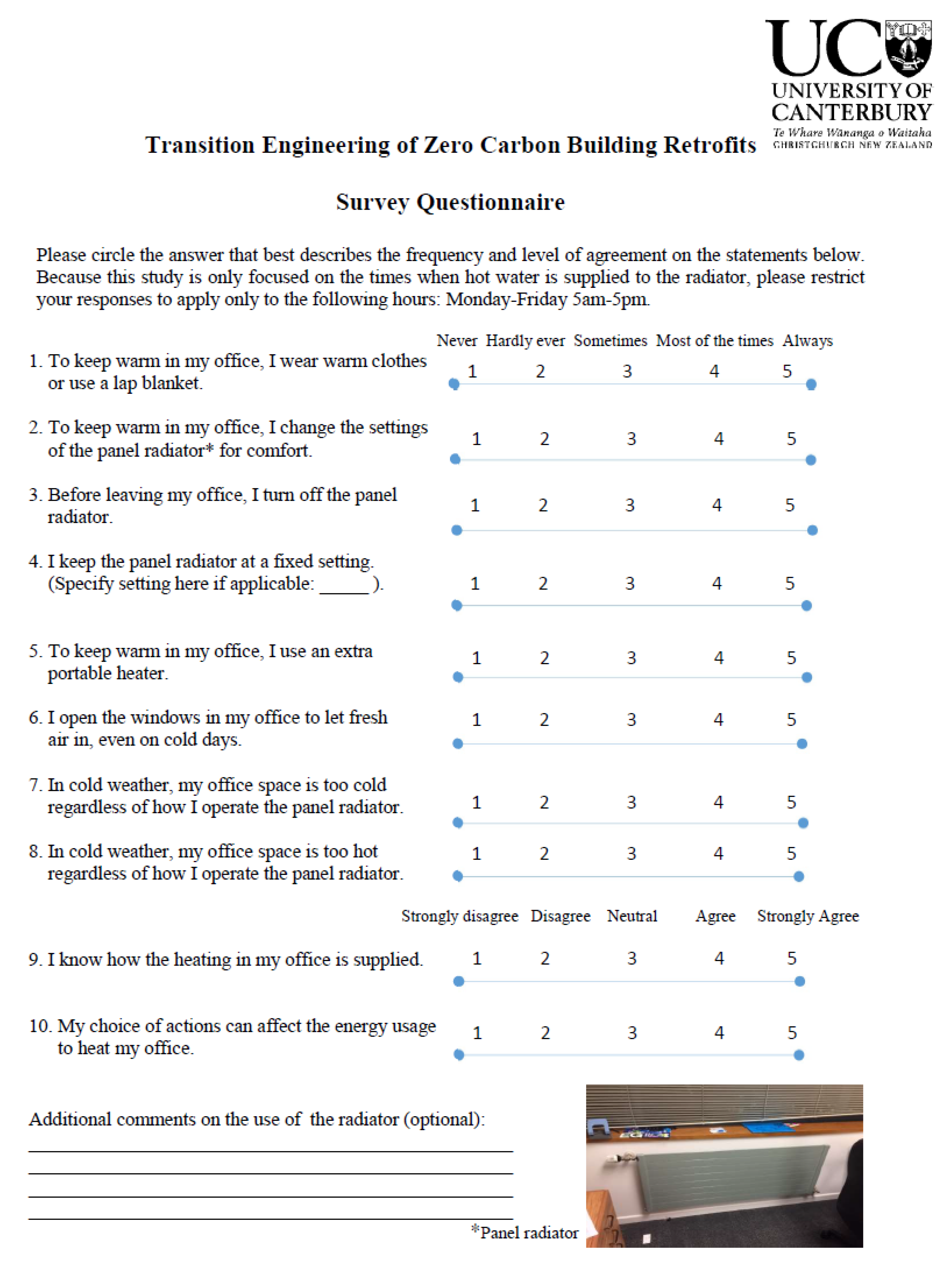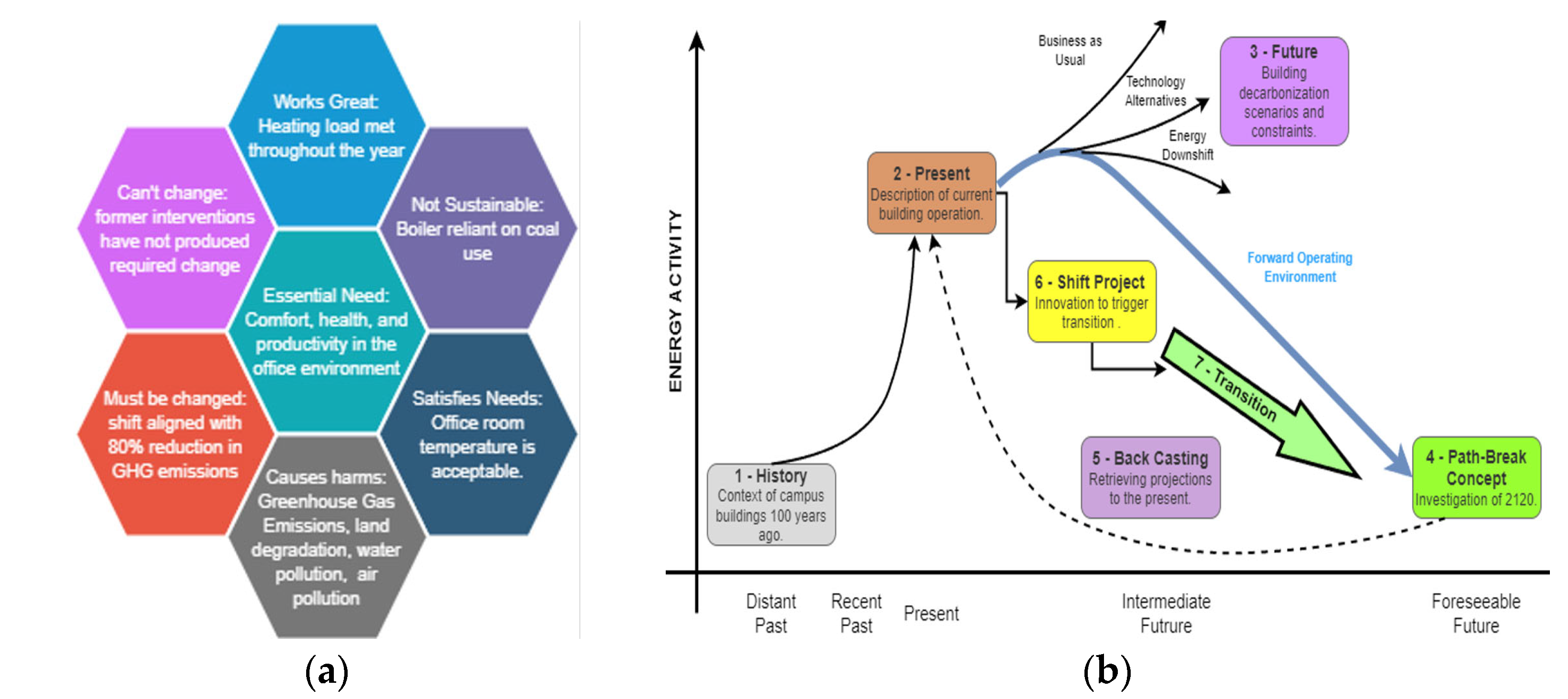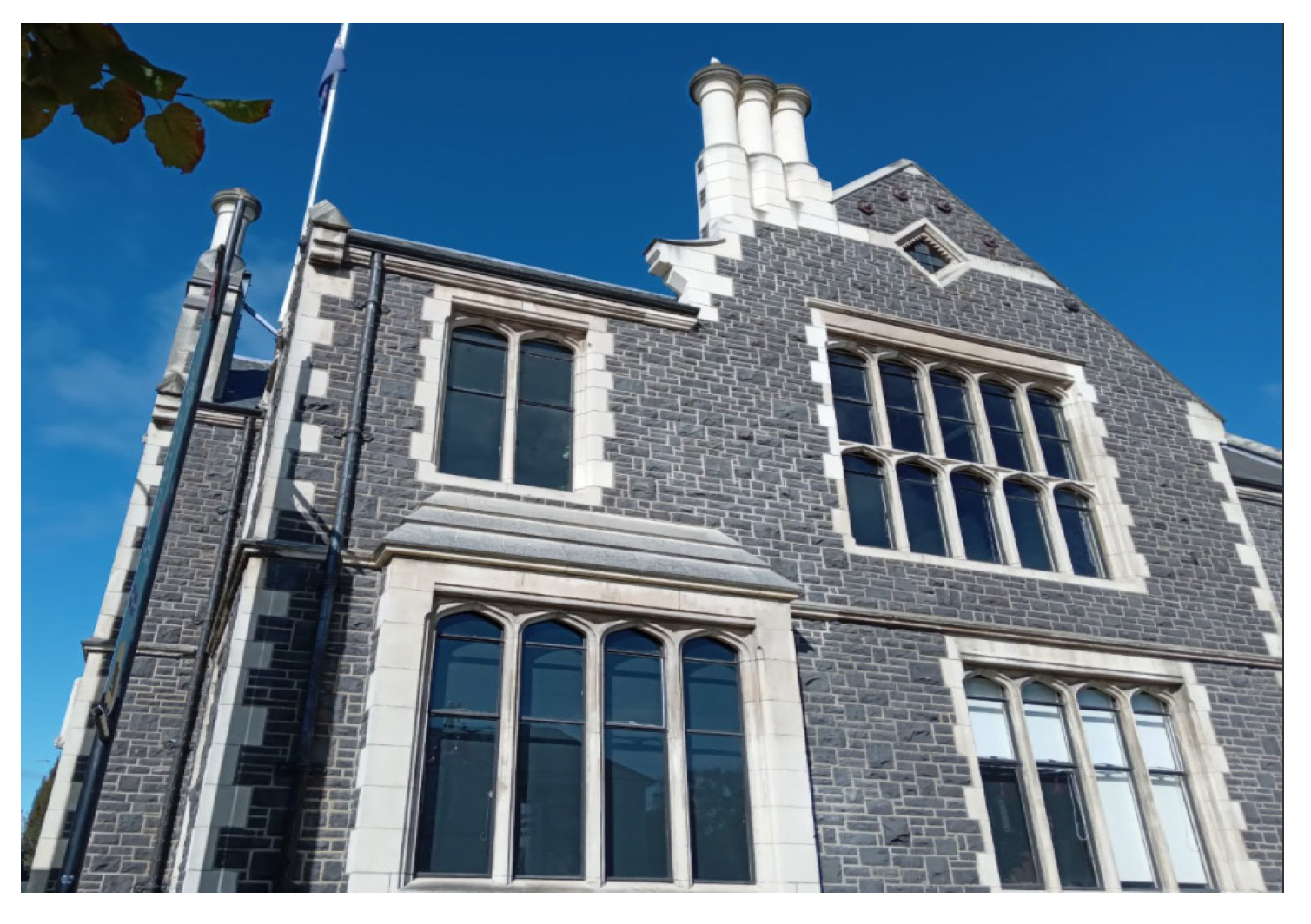Application of the InTIME Methodology for the Transition of Office Buildings to Low Carbon—A Case Study
Abstract
:1. Introduction
1.1. Energy Management Background
1.2. Energy Transition Engineering
2. Methodology: Transition Engineering Analysis
3. Wicked Problem Definition: Description of the Heating System and Energy Use Considerations
4. Application of the InTIME Methodology to the Case Study
5. Emerging Concept: THE-AID Program
5.1. Energy Audit
5.2. Evaluation of Heating Behaviour
5.3. Intervention Design
6. Discussion
7. Conclusions
Author Contributions
Funding
Acknowledgments
Conflicts of Interest
Appendix A

References
- UNEP. 2021 Global Status Report for Buildings and Construction: Towards a Zero-Emission, Efficient and Resilient Buildings and Construction Sector; United Nations Environment Programme: Nairobi, Kenya, 2021. [Google Scholar]
- IEA. Tracking Buildings 2021; IEA: Amsterdam, The Netherlands, 2021. [Google Scholar]
- IEA. Global Energy Review; IEA: Amsterdam, The Netherlands, 2021. [Google Scholar]
- UNFCCC. Paris Agreement; UNFCCC: Bonn, Germany, 2015. [Google Scholar]
- UNFCCC. The Glasgow Climate Pact; UNFCCC: Bonn, Germany, 2021. [Google Scholar]
- Krumdieck, S. Engineering Transition: Building a Sustainable Future; CRC Press LLC: Milton, ON, Canada, 2019. [Google Scholar]
- Rogelj, J.; Shindell, D.; Jiang, K.; Fifita, S.; Forster, P.; Ginzburg, V.; Handa, C.; Kheshgi, H.; Kobayashi, S.; Kriegler, E.; et al. Mitigation Pathways Compatible with 1.5 °C in the Context of Sustainable Development; IPCC: Paris, France, 2018. [Google Scholar]
- Simha, R.V. Willis H carrier: Father of air conditioning. Resonance 2012, 17, 117–138. [Google Scholar] [CrossRef]
- Economidou, M.; Todeschi, V.; Bertoldi, P.; D’Agostino, D.; Zangheri, P.; Castellazzi, L. Review of 50 years of EU energy efficiency policies for buildings. Energy Build. 2020, 225, 110322. [Google Scholar] [CrossRef]
- Lifset, R.D. A New Understanding of the American Energy Crisis of the 1970s. Hist. Soc. Res. 2014, 39, 22–42. [Google Scholar] [CrossRef]
- Soeder, D.J. The Energy Crisis and Unconventional Resources. In Fracking and the Environment; Springer International Publishing: Cham, Switzerland, 2020; pp. 63–78. [Google Scholar]
- McKay, M.H. New Zealand and the Oil Crisis: An Examination of Foreign Policy Reactions. Master’s Thesis, University of Canterbury, Christchurch, New Zealand, 1975. [Google Scholar]
- IPCC. Fifth Assessment Report; IPCC: Paris, France, 2014. [Google Scholar]
- Spiru, P.; Simona, P.L. A review on interactions between energy performance of the buildings, outdoor air pollution and the indoor air quality. Energy Procedia 2017, 128, 179–186. [Google Scholar] [CrossRef]
- Verleger, P.K., Jr. Understanding the 1990 Oil Crisis. Energy J. 1990, 11, 15–33. [Google Scholar] [CrossRef]
- Joskow, P.L. U.S. Energy Policy during the 1990s; National Bureau of Economic Research: Cambridge, MA, USA, 2001; Available online: https://www.nber.org/papers/w8454 (accessed on 9 August 2022).
- Uz, D. Energy efficiency investments in small and medium sized manufacturing firms: The case of California energy crisis. Energy Econ. 2018, 70, 421–428. [Google Scholar] [CrossRef]
- Sajid, Z.; Javaid, A. A stochastic approach to energy policy and management: A case study of the Pakistan energy crisis. Energies 2018, 11, 2424. [Google Scholar] [CrossRef]
- Lodhi, R.N.; Malik, R.K. Impact of Electricity Shortage on Daily Routines: A Case Study of Pakistan. Energy Environ. 2013, 24, 701–709. [Google Scholar] [CrossRef]
- MacGregor, C.; Dowdell, D.C.; Jaques, R.A.; Bint, L.; Berg, B.L. The Built Environment and Climate Change: A Review of Research, Challenges and the Future; BRANZ: Jugendford, New Zealand, 2018. [Google Scholar]
- Monstadt, J.; Wolff, A. Energy transition or incremental change? Green policy agendas and the adaptability of the urban energy regime in Los Angeles. Energy Policy 2015, 78, 213–224. [Google Scholar] [CrossRef]
- Ministry of Business, Innovation and Employment. Transforming Operational Efficiency; MBIE: Wellington, New Zealand, 2020. [Google Scholar]
- IEA. Global CO2 Emissions in 2019; IEA: Amsterdam, The Netherlands, 2020. [Google Scholar]
- Ministry of Business, Innovation and Employment (MBIE). Electricity Demand and Generation Scenarios: Scenario and Results Summary; Ministry of Business, Innovation and Employment (MBIE): Wellington, New Zealand, 2019. [Google Scholar]
- Risch, A. Are environmental fiscal incentives effective in inducing energy-saving renovations? An econometric evaluation of the French energy tax credit. Energy Econ. 2020, 90, 104831. [Google Scholar] [CrossRef]
- Krumdieck, S.; Hamm, A. Strategic analysis methodology for energy systems with remote island case study. Energy Policy 2009, 37, 3301–3313. [Google Scholar] [CrossRef]
- Krumdieck, S.; Page, S.; Dantas, A. Urban form and long-term fuel supply decline: A method to investigate the peak oil risks to essential activities. Transp. Res. Part A Policy Pract. 2010, 44, 306–322. [Google Scholar] [CrossRef]
- Watcharasukarn, M.; Page, S.; Krumdieck, S. Virtual reality simulation game approach to investigate transport adaptive capacity for peak oil planning. Transp. Res. Part A Policy Pract. 2012, 46, 348–367. [Google Scholar] [CrossRef]
- Bai, M.; Krumdieck, S. Transition engineering of transport in megacities with case study on commuting in Beijing. Cities 2020, 96, 102452. [Google Scholar] [CrossRef]
- Gallardo, P.; Murray, R.; Krumdieck, S.J.E. A Sequential Optimization-Simulation Approach for Planning the Transition to the Low Carbon Freight System with Case Study in the North Island of New Zealand. Energies 2021, 14, 3339. [Google Scholar] [CrossRef]
- Global Association for Transition Engineering. Interdisciplinary Transition Innovation, Management and Engineering (InTIME). 2019. Available online: https://www.transitionengineering.org (accessed on 9 August 2022).
- American Society of Heating, Refrigerating, and Air-Conditioning Engineers. ASHRAE Handbook—Foundamentals (SI); ASHRAE: Atlanta, GA, USA, 2017. [Google Scholar]
- Facilities Management, University of Canterbury. Ilam Campus MTHW Boilerplant; University of Canterbury: Christchchurch, New Zealand, 2016. [Google Scholar]
- Clifford, G.E. Heating, Ventilating and Air Conditioning; Reston Pub: Seattle, WA, USA, 1984. [Google Scholar]
- Zenginis, D.G.; Zenginis, D.G.; Kontoleon, K.J.; Kontoleon, K.J. Influence of orientation, glazing proportion and zone aspect ratio on the thermal performance of buildings during the winter period. Environ. Sci. Pollut. Res. Int. 2018, 25, 26736–26746. [Google Scholar] [CrossRef]
- Arriazu-Ramos, A.; Monge-Barrio, A.; Bellod, J.S.M.; Martínez, P.G.; Gutiérrez, A.S.-O. Difficulties in the energy renovation processes of district heating buildings. Two case studies in a temperate climate. Sustain. Cities Soc. 2021, 75, 103246. [Google Scholar] [CrossRef]
- Zhao, S.; Yang, L.; Gao, S.; Li, M.; Yan, H.; Zhai, Y. Field investigation on the thermal environment and thermal comfort in shopping malls in the cold zone of China. Build. Environ. 2022, 214, 108892. [Google Scholar] [CrossRef]
- Huang, L.; Zhai, Z. Critical review and quantitative evaluation of indoor thermal comfort indices and models incorporating solar radiation effects. Energy Build. 2020, 224, 110204. [Google Scholar] [CrossRef]
- Young, J. Fuelling Dissension: Coal and Coal Mining in 21st Century New Zealand; Triple Helix Resources Ltd.: Owaka, New Zealand, 2019. [Google Scholar]
- Sustainability Office. Sustainable Operations—Our Energy Journey. Available online: https://www.canterbury.ac.nz/life/sustainability/sustainable-operations/energy-and-carbon/ (accessed on 18 July 2022).
- Graham, B.N.H. Air Pollution Monitoring in New Zealand 1960–1992. 1994. Available online: https://www.moh.govt.nz/notebook/nbbooks.nsf/0/BC5A0A6EBA09992A4C256655000C6518/$file/air-pollution-monitoring-in-New-Zealand-1960-1992.pdf (accessed on 9 August 2022).
- Petroleum&Minerals New Zealand. Operating Coal Mine Production Figures. 2019. Available online: https://www.nzpam.govt.nz/nz-industry/nz-minerals/minerals-statistics/coal/operating-mines/ (accessed on 9 August 2022).
- University of Canterbury, Facilities Management, Sustainability Office. 2018 UC Sustainability Report. Available online: https://www.canterbury.ac.nz/media/documents/reports/UC-Sustainability-Report-2018.pdf (accessed on 9 August 2022).
- University of Canterbury, Facilities Management, Sustainability Office. 2019 UC Sustainability Report. Available online: https://www.canterbury.ac.nz/life/sustainability/sustainability-office-and-programme-board/sustainability-office-reports/UC-Sustainability-Report-2019-V5.pdf (accessed on 9 August 2022).
- University of Canterbury, Facilities Management, Sustainability Office. 2020 UC Sustainability Report. Available online: https://www.canterbury.ac.nz/life/sustainability/sustainability-office-and-programme-board/sustainability-office-reports/UC-Sustainability-Report-2020.pdf (accessed on 9 August 2022).
- New Zealand’s Minerals and Petroleum Industry. In Operating Coal Mine Production Figures; New Zealand’s Minerals and Petroleum Industry: Wellington, New Zealand, 2021.
- New Zealand Ministry of Business, Innovation and Employment. Energy in New Zealand. 2018. Available online: https://www.mbie.govt.nz/assets/d7c93162b8/energy-in-nz-18.pdf (accessed on 9 August 2022).
- Canterbury, U.O. UC News. Available online: https://www.canterbury.ac.nz/news/2020/biomass-boiler-funding-of-6m-takes-uc-closer-to-sustainability-targets-.html (accessed on 26 November 2020).
- Eng, G.; Bywater, I.; Hendtlass, C.A. New Zealand Energy Information Handbook, 3rd ed.; New Zealand Centre for Advanced Engineering: Christchurch, New Zealand, 2008. [Google Scholar]
- Naumann, G.; Schropp, E.; Gaderer, M. Life Cycle Assessment of an Air-Source Heat Pump and a Condensing Gas Boiler Using an Attributional and a Consequential Approach. Procedia CIRP 2022, 105, 351–356. [Google Scholar] [CrossRef]
- Association, B. Wood Fuel in New Zealand is Produced from Carbon Neutral Biomass from Plantation Forests; World Bioenergy Association: Stockholm, Sweden, 2019. [Google Scholar]
- Research, F. Typical Calorific Values of Fuels. Available online: https://www.forestresearch.gov.uk/tools-and-resources/fthr/biomass-energy-resources/reference-biomass/facts-figures/typical-calorific-values-of-fuels/ (accessed on 9 August 2022).
- Walmsley, M.R.W.; Walmsley, T.G.; Matthews, L.; Atkins, M.J.; Neale, J.R.; Kamp, P. Pinch Analysis Techniques for Carbon Emissions Reduction in the New Zealand Industrial Process Heat Sector. Chem. Eng. Trans. 2015, 45, 1087–1092. [Google Scholar] [CrossRef]
- EECA. Fonterra Coal Boiler Conversion. 2020. Available online: https://www.eeca.govt.nz/insights/case-studies-and-articles/fuel-switching-captures-economic-and-climate-benefits-for-fonterra/ (accessed on 9 August 2022).
- Wood Energy SouthCase Study: Splash Palace, Invercargill. 2020. Available online: https://www.bioenergy.org.nz/resource/case-study-675kw-binder-chip-boiler-splash-palace-invercargill (accessed on 9 August 2022).
- Department of Energy. Best Practice Guideline for Life Cycle Analysis of Heat Supply Projects. 2018. Available online: https://www.energy.gov/sites/default/files/2022-06/FECM%20DACS%20LCA%20Best%20Practices.pdf (accessed on 9 August 2022).
- Ashfaq, A.; Ianakiev, A. Cost-minimised design of a highly renewable heating network for fossil-free future. Energy 2018, 152, 613–626. [Google Scholar] [CrossRef]
- MBIE. Energy Prices. Available online: https://www.mbie.govt.nz/building-and-energy/energy-and-natural-resources/energy-statistics-and-modelling/energy-statistics/energy-prices/ (accessed on 9 August 2022).
- BECA. Analysis to Inform A Review of Large Non-Residential and Apartment Building Thermal Performance Settings and Climate Zones; BECA: Auckland, New Zealand, 2021. [Google Scholar]
- NZ MBIE. Process Heat in New Zealand; MBIE: Wellington, New Zealand, 2018. [Google Scholar]
- New Zealand Parliamentary Counsel Office.Climate Change Response (Zero Carbon) Amendment Act 2019. 2019. Available online: https://environment.govt.nz/acts-and-regulations/acts/climate-change-response-amendment-act-2019/ (accessed on 9 August 2022).
- Liu, J.; Yao, R.; McCloy, R. A method to weight three categories of adaptive thermal comfort. Energy Build. 2012, 47, 312–320. [Google Scholar] [CrossRef]
- Nicol, J.F.; Humphreys, M.A. Adaptive thermal comfort and sustainable thermal standards for buildings. Energy Build. 2002, 34, 563–572. [Google Scholar] [CrossRef]
- Coley, D.; Herrera, M.; Fosas, D.; Liu, C.; Vellei, M. Probabilistic adaptive thermal comfort for resilient design. Build. Environ. 2017, 123, 109–118. [Google Scholar] [CrossRef]
- Liu, J.; Yao, R.; McCloy, R. An investigation of thermal comfort adaptation behaviour in office buildings in the UK. Indoor Built Environ. 2014, 23, 675–691. [Google Scholar] [CrossRef]
- Brager, G.S.; de Dear, R.J. Thermal adaptation in the built environment: A literature review. Energy Build. 1998, 27, 83–96. [Google Scholar] [CrossRef]
- Yeganeh, A.J.; Reichard, G.; McCoy, A.P.; Bulbul, T.; Jazizadeh, F. Correlation of ambient air temperature and cognitive performance: A systematic review and meta-analysis. Build. Environ. 2018, 143, 701–716. [Google Scholar] [CrossRef]
- Soriano, A.; Kozusznik, M.W.; Peiro, J.M. From Office Environmental Stressors to Work Performance: The Role of Work Patterns. Int. J. Environ. Res. Public Health 2018, 15, 1633. [Google Scholar] [CrossRef]
- Yan, D.; Hong, T.; Dong, B.; Mahdavi, A.; D’Oca, S.; Gaetani, I.; Feng, X. IEA EBC Annex 66: Definition and simulation of occupant behavior in buildings. Energy Build. 2017, 156, 258–270. [Google Scholar] [CrossRef] [Green Version]
- D’Oca, S.; Chen, C.-F.; Hong, T.; Belafi, Z. Synthesizing building physics with social psychology: An interdisciplinary framework for context and occupant behavior in office buildings. Energy Res. Soc. Sci. 2017, 34, 240–251. [Google Scholar] [CrossRef]
- Paone, A.; Bacher, J.-P. The impact of building occupant behavior on energy efficiency and methods to influence it: A review of the state of the art. Energies 2018, 11, 953. [Google Scholar] [CrossRef]
- Gunay, H.B.; O’Brien, W.; Beausoleil-Morrison, I. A critical review of observation studies, modeling, and simulation of adaptive occupant behaviors in offices. Build. Environ. 2013, 70, 31–47. [Google Scholar] [CrossRef]
- Harputlugil, T.; de Wilde, P. The interaction between humans and buildings for energy efficiency: A critical review. Energy Res. Soc. Sci. 2021, 71, 101828. [Google Scholar] [CrossRef]
- Lopes, M.A.R.; Antunes, C.H.; Martins, N. Energy behaviours as promoters of energy efficiency: A 21st century review. Renew. Sustain. Energy Rev. 2012, 16, 4095–4104. [Google Scholar] [CrossRef]
- Goswami, D.Y.; Kreith, F. Energy Management and Conservation Handbook, 2nd ed.; CRC Press: Boca Raton, FL, USA, 2017. [Google Scholar]
- Ajzen, I. The theory of planned behavior. Organ. Behav. Hum. Decis. Process. 1991, 50, 179–211. [Google Scholar] [CrossRef]
- Triandis, H. Interpersonal Behavior; Brooks/Cole Pub. Co.: Monterey, CA, USA, 1977; Volume 1. [Google Scholar]





| Technology Alternative | Initial Investment | Cost Burden in Time | Supply Chain Risks | Future Environmental Commitment | Estimated Implementation Time |
|---|---|---|---|---|---|
| Biomass (wood chip/pellet boiler) | New boiler + tech conversion + fuel storage and handling space | Fuel storage Lessened revenues from UC forestry lease Increasing carbon cost | Finite resources A limited number of suppliers. | Reforestation and implications of plantation forestry | 2 years + |
| Electric heaters/heat pumps | New equipment + transformer upgrade | Costly operation and maintenance | Blackout/Brownout | Peak management (fossil fuels required) | 3 years + |
| Ground source heat pumps | New infrastructure | Maintenance of equipment and bores | Limited resource access | Artesian wells at risk of over-extraction | N/A to supply all buildings |
| Scenario | BAU − Coal | WCPB | ASHP | BER + Coal |
|---|---|---|---|---|
| Primary Energy Input (MWh/year) | 30,000 (−0%) | 30,000 (−0%) | 8000 (−73%) | 17,100 (−43%) |
| Fuel Mass (T/year) | 6000 | 8500 | n/a | 3420 |
| Operational Carbon Emissions [53] (TCO2/year) | 12,300 (−0%) | 140 (−98%) | 400 (−96%) | 7000 (−43%) |
| Peak Heat Power (MW) | 15.5 (−0%) | 15.5 (−0%) | 11.2 (−28%) | 12.4 (−20%) |
| Air Pollution | Unchanged | Unchanged | None | Reduced |
| CAPEX (MNZ$) | 0 | 15 | 11 | 51 |
| Fuel OPEX (MNZ$/yr) | 1.9 | 1.3–2.2 | 1.6 | 1.1 |
| Scenario | Adaptive Capacity + Coal | Sustainable Transition |
|---|---|---|
| Primary Energy Input (MWh/year) | 6000 (−80%) | 6000 (−80%) |
| Fuel Mass (T/year) | 1200 | 1700 |
| Operational Carbon Emissions (TCO2/year) | 2500 (−80%) | 30 (−99%) |
| Peak Heat Power (MW) | 4 (−75%) | 4 (−75%) |
| Air Pollution | Significantly reduced | Significantly reduced |
| CAPEX (MNZ$) | 0 | >4 |
| Fuel OPEX (MNZ$/yr) | 0.4 | 0.3–0.5 |
| Type of Behavioural Intervention | Sub-Class | User Attribute |
|---|---|---|
| Information | Targeted information campaigns | Low PBC/FC |
| Educational programs/training | Low habitual adaptive behaviour | |
| Type of Physical Intervention | Sub-Class | Office Characteristics/User Attribute |
| Office modifications | Reallocation to a different thermal zone in the building | Low thermal performance (office) Physiological deficiencies |
| Furniture rearrangement | Low thermal performance (office) Low habitual adaptive behaviour | |
| Access to heating controls | Low PBC/FC | |
| New heating equipment | Physiological deficiencies |
Publisher’s Note: MDPI stays neutral with regard to jurisdictional claims in published maps and institutional affiliations. |
© 2022 by the authors. Licensee MDPI, Basel, Switzerland. This article is an open access article distributed under the terms and conditions of the Creative Commons Attribution (CC BY) license (https://creativecommons.org/licenses/by/4.0/).
Share and Cite
Andrade, I.; Land, J.; Gallardo, P.; Krumdieck, S. Application of the InTIME Methodology for the Transition of Office Buildings to Low Carbon—A Case Study. Sustainability 2022, 14, 12053. https://doi.org/10.3390/su141912053
Andrade I, Land J, Gallardo P, Krumdieck S. Application of the InTIME Methodology for the Transition of Office Buildings to Low Carbon—A Case Study. Sustainability. 2022; 14(19):12053. https://doi.org/10.3390/su141912053
Chicago/Turabian StyleAndrade, Isabel, Johann Land, Patricio Gallardo, and Susan Krumdieck. 2022. "Application of the InTIME Methodology for the Transition of Office Buildings to Low Carbon—A Case Study" Sustainability 14, no. 19: 12053. https://doi.org/10.3390/su141912053
APA StyleAndrade, I., Land, J., Gallardo, P., & Krumdieck, S. (2022). Application of the InTIME Methodology for the Transition of Office Buildings to Low Carbon—A Case Study. Sustainability, 14(19), 12053. https://doi.org/10.3390/su141912053







